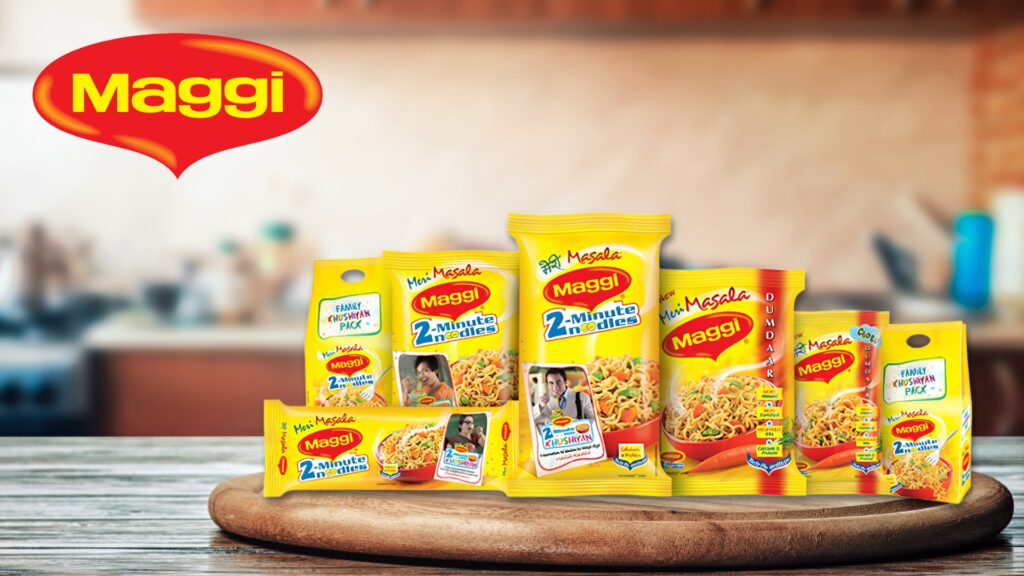
Maggi, once a beloved household name in India, found its trusted image shattered almost overnight. Accusations of excessive lead content and misleading “No Added MSG” labels sparked a nationwide uproar, putting the iconic noodle brand in hot water.
For generations, Maggi wasn’t just a snack it was a sentiment. The phrase “Mummy, bhookh lagi hai!” instantly evoked memories of the familiar aroma of Maggi Masala simmering in kitchens across India. Since its 1983 launch, Maggi had become more than a product; it was a comforting ritual wrapped in a yellow packet.
But in 2015, everything changed.
The Crisis That Cooked Up Trouble
The controversy began in Uttar Pradesh when officials detected high lead levels in Maggi samples. Soon, other states followed suit. By June 2015, the Food Safety and Standards Authority of India (FSSAI) had imposed a nationwide ban.
Nestlé, Maggi’s parent company, initially mishandled the situation. Its early response marked by denials and technical defenses only fueled public outrage. By the time Nestlé’s global CEO Paul Bulcke arrived in India to take charge, the damage was extensive. Maggi’s market share nosedived from 80% to zero, sales dropped by 90%, over 30,000 tonnes of noodles were recalled and destroyed, and the company reported its first quarterly loss in 15 years.
Rebuilding From the Ashes
Despite the devastation, Maggi wasn’t finished. The brand held one powerful asset: emotional equity. For millions, Maggi was more than food it was comfort during hostel days, late-night cravings, and mother’s quick-fix meals.
Nestlé realized that emotional connection alone wouldn’t suffice. The comeback had to be rooted in hard facts and genuine trust-building.
Step 1: Scientific Validation
Nestlé launched an extensive safety check across Indian and international labs, testing over 3,500 Maggi samples in countries including the US, UK, Canada, and Singapore. All tests showed that lead levels were within acceptable limits. The company also undertook the massive logistical task of recalling and destroying contaminated stock over 30,000 tonnes demonstrating its commitment to consumer safety.
To reinforce credibility, Nestlé agreed to court-monitored third-party testing by NABL-accredited labs, laying a rational foundation for its next step: winning back hearts.
Step 2: Shifting the Communication Tone
Nestlé’s communication strategy transformed. The tone shifted from defensive to empathetic and transparent. Full-page ads reassured customers that Maggi was safe. Websites and social media channels featured FAQs, explainer videos, and behind-the-scenes footage to rebuild trust. The brand stopped justifying and started listening acknowledging the emotional impact of the incident.
Step 3: Reigniting the Emotional Bond
One of Maggi’s most memorable campaigns, #WeMissYouToo, echoed the nation’s collective nostalgia. Rather than sell, the brand shared in the sadness showcasing emotional moments where Maggi was missed: in dorms, kitchens, and bachelor homes. Another campaign, #LetYourMomKnow, directly addressed mothers Maggi’s original trust base offering reassurance that the noodles were now safer and better.
Nestlé encouraged users to share their personal Maggi stories under the #NothingLikeMaggi movement, tapping into the deep connection people had with the brand.
Step 4: A Strategic, Phased Relaunch
Rather than flood shelves immediately, Maggi returned in phases. It first relaunched exclusively on Snapdeal, generating curiosity and demand in the still-nascent e-commerce space. Only the classic Masala variant was brought back initially to reinforce familiarity. Once confidence returned, other variants followed, supported by a mix of TV, print, retail, and digital campaigns.
The Comeback Story
By March 2016, Maggi had regained more than 50% of its lost market share. By late 2017, it was back to around 60% a significant recovery, especially in a now more competitive and cautious market.
Maggi’s return was not merely about nostalgia it was a masterclass in crisis management. The brand’s revival demonstrated a vital lesson: rebuilding trust takes both evidence and emotion. Without first proving safety through science, emotional appeals would have fallen flat. Maggi’s journey became a benchmark in how to recover and thrive after a brand disaster.









